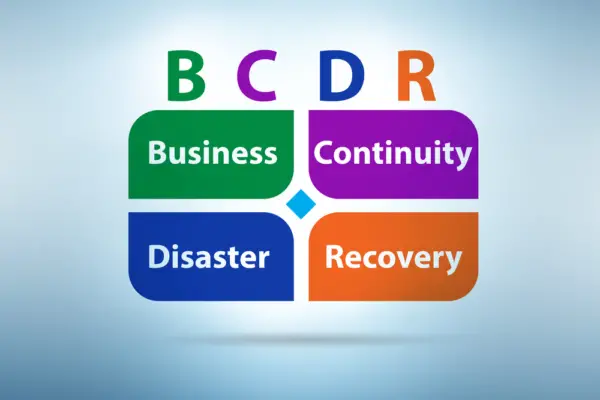Business Continuity Risk Assessment is for organizations to identify and evaluate potential risks that could disrupt their operations. This assessment aims to ensure the continuity of business activities in the face of unforeseen events such as natural disasters, cyber-attacks, or supply chain disruptions.
Systematically analyzing and categorizing risks, organizations can develop effective strategies to mitigate them and enhance their resilience.
Various types of risks must be assessed during the Business Continuity Risk Assessment process. These include operational risks, technological risks, financial risks, legal and regulatory risks, reputational risks, and strategic risks.
Each type of risk brings its own unique challenges and requires specific attention.
Organizations often utilize templates in spreadsheet formats like xls (Excel) to facilitate the Business Continuity Risk Assessment process.
These templates typically include risk identification criteria, risk assessment scales, impact analysis tools, mitigation strategies, and monitoring mechanisms.
Conducting a comprehensive Business Continuity Risk Assessment using an xls template, organizations can gain valuable insights into their vulnerabilities and develop proactive measures to minimize potential disruptions.
This article explores the importance of this assessment process and highlights key components of a Business Continuity Risk Assessment xls template.

Definition of Business Continuity Risk Assessment
Business Continuity Risk Assessment refers to the process of identifying and evaluating potential risks that could disrupt a business’s operations.
It involves conducting a comprehensive analysis of various threats, vulnerabilities, and potential impacts to assess the overall risk level faced by an organization.
This assessment helps businesses understand their exposure to risks and enables them to develop effective strategies for mitigating these risks, thus ensuring continuity of operations in the face of unexpected events.
Benefits of Business Continuity Risk Assessment
Conducting a comprehensive business continuity risk assessment allows organizations to identify potential vulnerabilities and develop proactive mitigation strategies.
The benefits of business continuity risk assessment are numerous. Firstly, it provides a structured approach for identifying and assessing risks, ensuring that all potential threats are considered.
Secondly, it enables organizations to determine risk tolerance and prioritize resources accordingly.
It also helps develop a risk treatment plan by evaluating the effectiveness of existing controls and implementing new ones where necessary.
Moreover, conducting a comprehensive business continuity risk assessment facilitates the development of effective risk management strategies by considering the likelihood and impact of various risks.
It also aids in understanding the residual risk factor after implementing control measures.
Lastly, it assists in maintaining an up-to-date record of identified risks through a risk register and provides valuable insights for future decision-making through the analysis of continuity exercise reports from data.
Types of Risks that Must Be Assessed
This includes the risks that must be assessed in a business continuity risk assessment.
These risks include:
- Natural risks, such as those caused by weather events or geological disasters.
- Man-made risks encompass hazards created by human activities such as infrastructure failures or cyberattacks.
- Environmental risks, which involve potential harm to the environment and ecosystems.
- Facility risks pertain to threats to physical structures and operations within an organization.
- Client master risks, which relate to vulnerabilities within client systems or networks.
Assessing these various risks is crucial for organizations to plan and implement business continuity strategies effectively.
Natural Risks
Natural risks pose significant threats to the continuity of operations and require careful consideration in risk management assessments. These potential risks include environmental risks, such as hurricanes, earthquakes, floods, and wildfires, which can cause severe damage to facilities and disrupt business operations.
To effectively assess natural risks, businesses need to adopt a comprehensive approach to risk assessment. This involves identifying the inherent risk associated with specific natural events and evaluating their potential impact on the organization’s ability to continue its operations.
One way to facilitate this process is by utilizing business continuity risk assessment templates designed to address environmental risks. These templates provide a structured framework for assessing facility risks.
This helps organizations leverage their experience in risk management to develop effective mitigation strategies. By thoroughly assessing natural risks, businesses can better prepare themselves for potential disruptions and safeguard their continuity of operations.
| Natural RisksApproach towards Risk Assessment | |
|---|---|
| Environmental Risks | Identify inherent risk |
| Facility Risks | Evaluate impact |
Man-Made Risks
Man-made risks encompass a range of potential threats that can disrupt business operations and require careful consideration in risk management assessments. These risks are caused by human actions, such as intentional sabotage, cyber-attacks, or accidents resulting from negligence.
When conducting a business continuity risk assessment, it is essential to identify and evaluate man-made risks, as they can significantly impact the organization’s ability to function effectively.
Risk items related to man-made risks and appropriate risk mitigation measures should be included in the assessment process.
A comprehensive understanding of the organization’s risk profile helps prioritize these risks based on severity. This can be achieved using a risk ranking or rating matrix. Implementing appropriate measures to reduce vulnerability to these risks is crucial for minimizing potential disruption to business operations.
Ultimately, senior management is critical in assessing and managing man-made risks effectively.
Environmental Risks
Environmental risks encompass many potential threats that can significantly affect organizational operations and necessitate careful consideration in risk management evaluations.
These external threats can include bomb threats, weather-related threats, and other high-quality threats that threaten the continuity of business operations.
One of the organizations’ biggest threats is their vulnerability to these environmental risks. To address this issue, organizations must conduct regular business continuity exercises and plan exercises to assess their preparedness and response capabilities.
Doing so, they can identify areas of weakness or improvement and develop strategies to mitigate the impact of environmental risks.
The findings from these exercises should be documented in a comprehensive business continuity exercise report, which serves as a valuable resource for future risk management efforts.
Facility Risks
Facility risks are a crucial aspect of organizational risk management evaluations, as they encompass an array of potential threats that can impact the continuity of operations and necessitate careful consideration in mitigation strategies.
These risks include physical damage to facilities due to natural disasters, equipment failure, or security breaches. Conducting a comprehensive facility risk assessment using a risk assessment tool is essential for identifying and prioritizing these risks.
The assessment should consider factors such as the organization’s risk appetite, regulatory compliance rule requirements, technology requirements, recovery time objective, restoration procedures, plan activation procedures, and employee welfare.
Evaluating facility risks in a structured manner using a risk assessment template suite, organizations can develop effective strategies for mitigating these threats and ensuring the uninterrupted operation of their business functions.
| Risk CategoryPotential RisksMitigation Strategies | ||
|---|---|---|
| Physical Threats | Natural disasters | Implement disaster recovery plans and backup systems |
| Equipment failure | Regular maintenance and inspections | |
| Security breaches | Enhance security measures and access controls | |
| Infrastructure | Power outages | Install backup power generators |
| Network disruptions | Establish redundant network connections | |
| Personnel | Workforce availability | Cross-training employees for critical tasks |
| Employee safety | Develop emergency evacuation plans |
Client Master Risks
The risks associated with managing client master data require careful consideration to ensure the integrity and accuracy of the information, as any errors or discrepancies can have significant consequences for organizational operations.
To effectively address these risks, it is important to identify and understand key risk areas.
- Key risk: The potential for unauthorized access or disclosure of client data.
- Level of risk: Assessing the likelihood and impact of security breaches.
- Relation to risk identification: Identifying vulnerabilities in client data management processes.
- Document updates: Regularly reviewing and updating policy documents related to client data management.
- Technical documents: Ensuring that technical documentation accurately reflects processing requirements for client master data.
Addressing these key areas, organizations can mitigate the risks associated with managing client master data. This will protect sensitive information and ensure a smooth recovery process in unforeseen events.
Key Risk Areas
The previous subtopic discussed the client master risks organizations must consider in their business continuity risk assessment. Now, let’s focus on the key risk areas related to these risks.
These areas are crucial as they directly impact an organization’s ability to meet audit, compliance, and regulatory requirements. Furthermore, they involve time-critical activities such as notification and technical recovery procedures.
It is important to thoroughly evaluate the diligence process for effectively identifying and addressing these risks during the assessment process.
Critical suppliers should also be included in this evaluation, as any disruption in their operations could significantly impact an organization’s ability to maintain business continuity. To provide a comprehensive understanding of these key risk areas, a table is presented below:
| Key Risk AreasDescription | |
|---|---|
| Audit Requirements | Ensuring that all relevant audit requirements are met and documented |
| Compliance Requirements | Adhering to all necessary compliance regulations |
| Regulatory Requirements | Complying with all applicable regulatory obligations |
| Time Critical Activities | Identifying and addressing activities that require immediate attention |
| Notification Procedures | Establishing effective procedures for notifying stakeholders about any disruptions or changes |
| Technical Recovery Procedures | Developing robust technical recovery procedures to minimize downtime |
Components of a Business Continuity Risk Assessment Template
This discussion will focus on the key points related to a Business Continuity Risk Assessment Template.
These include:
- Senior management involvement and approval.
- A comprehensive review of the organization and its operations.
- Identification and analysis of potential risks.
Additionally, the template covers aspects such as:
- Risk tolerance.
- Treatment plan development.
- Implementation and maintenance of the plan.
Senior Management Involvement & Approval
Senior management involvement and approval are crucial for ensuring the comprehensive and unbiased assessment of business continuity risks, enhancing the organization’s ability to mitigate potential disruptions effectively.
Actively participating in the process, senior management demonstrates their commitment to the importance of business continuity planning. Their involvement ensures that all key areas are considered and resources are appropriately allocated for risk mitigation strategies.
Furthermore, obtaining senior management approval guarantees that top-level decision-makers have thoroughly reviewed and accepted the assessment.
To illustrate this point further, consider the following table:
| Practical exercise to test the effectiveness of plans | Description |
|---|---|
| Page Word Document | Main document outlining business continuity risk assessment |
| Additional Documents | Supporting materials such as checklists or templates |
| Archive File Document | Historical records of previous assessments |
| Supplemental Zip Document | Compressed files containing relevant information |
| Simple Business Continuity Exercise | Practical exercise to test effectiveness of plans |
Involving senior management throughout the process also allows for continuous improvement over time. They can provide valuable insights based on their experience and knowledge, ensuring that risk assessments remain up-to-date and aligned with organizational goals.
Additionally, their involvement emphasizes accountability and responsibility throughout the organization, ensuring business continuity is prioritized without time limits.
Lastly, senior management’s participation aids in fostering relationships with suppliers by encouraging them to develop robust supplier business continuity plans.

Comprehensive Review of the Organization and Its Operations
The comprehensive review of the organization’s structure and operations highlights the interconnectedness of its various departments and functions, shedding light on potential vulnerabilities and areas for improvement.
This level of analysis guarantees a thorough examination of the organization’s ability to withstand disruptions and recover within no time limits.
The review encompasses a period, allowing for an in-depth understanding of how the organization operates under different circumstances. Additionally, it involves assessing supplier business continuity schedules to ensure that external dependencies are accounted for.
Furthermore, employee contact information is carefully collected to facilitate effective emergency communication. This comprehensive review is a careful step towards identifying weaknesses within the organization and implementing necessary measures to strengthen resilience.
It involves numerous steps, including data collection, analysis, and consultation with relevant stakeholders, ultimately leading to a robust business continuity plan.
Identification & Analysis of Potential Risks
Identifying and analyzing potential risks is critical in ensuring organizational resilience and preparedness for unexpected disruptions. By proactively identifying and analyzing potential risks, organizations can develop effective strategies to mitigate the impact of these risks on their operations.
The process involves systematically assessing all aspects of the organization’s activities, including its infrastructure, systems, processes, and external factors that may pose a threat.
This could include natural disasters, cyber-attacks, supply chain disruptions, regulatory changes, or economic downturns.
A comprehensive risk assessment allows organizations to prioritize their resources and efforts toward addressing the most significant threats.
It also enables them to establish contingency plans and implement appropriate risk management measures to minimize the likelihood and severity of potential disruptions.
Conducting a thorough identification and analysis of potential risks enhances an organization’s ability to maintain continuity during challenging times.
Risk Tolerance & Treatment Plan Development
Risk tolerance plays a crucial role in developing a comprehensive treatment plan, as it determines the acceptable level of risk an organization is willing to undertake and guides the selection and implementation of appropriate risk management strategies.
Organizations must assess risk tolerance accurately, considering financial capacity, legal requirements, and stakeholder expectations. Understanding their risk tolerance, organizations can prioritize risks based on their potential impact and likelihood of occurrence.
This allows them to focus resources on managing higher-priority risks while accepting lower-priority risks within acceptable limits.
Developing a treatment plan involves identifying specific measures or actions to mitigate or transfer identified risks. These measures could include implementing control mechanisms, purchasing insurance coverage, or establishing contingency plans.
Organizations can effectively manage potential risks and ensure business continuity by aligning risk tolerance with treatment plans.
Implementation & Maintenance of the Plan
Implementation and maintenance of the plan involve ensuring that the identified measures are effectively implemented and regularly reviewed to address any emerging risks or changes in the organizational context.
This requires a systematic monitoring, evaluating, and updating the business continuity plan (BCP).
To facilitate this process, organizations can consider implementing the following steps:
- Regularly review and update the BCP based on emerging risks, technological changes, or organizational structure shifts.
- Conduct periodic tests and drills to assess the plan’s effectiveness and identify improvement areas.
- Include key stakeholders from different departments to ensure comprehensive testing.
- Document lessons learned from these exercises to inform future revisions.
- Establish a communication strategy to inform employees about their roles and responsibilities during an incident.
- Provide training sessions or workshops on crisis management procedures.
- Develop clear communication channels for prompt dissemination of information.
Following these steps, organizations can maintain an effective BCP that mitigates potential disruptions and ensures smooth operations during times of crisis.
Frequently Asked Questions
How often should a business conduct a business continuity risk assessment?
A business should periodically conduct a business continuity risk assessment to ensure that potential risks and vulnerabilities are identified and managed effectively.
The frequency of such assessments may vary depending on the nature of the business and its operating environment.
What are the key steps involved in conducting a business continuity risk assessment?
The key steps in conducting a business continuity risk assessment include identifying potential risks, evaluating their impact on the business, developing strategies to mitigate the risks, implementing and testing those strategies, and regularly reviewing and updating the assessment.
What are the common challenges or limitations when performing a business continuity risk assessment?
Common challenges and limitations in conducting a business continuity risk assessment include insufficient data or information, difficulty quantifying risks, lack of expertise or resources, resistance to change, and the dynamic nature of risks.
Are there any industry-specific or sector-specific risks that should be considered in a business continuity risk assessment?
Industry-specific and sector-specific risks should be considered in a business continuity risk assessment.
These risks can vary depending on the nature of the industry or sector, including regulatory compliance, supply chain disruptions, technology failures, and natural disasters.
What are some best practices or strategies for effectively communicating the results of a business continuity risk assessment to key stakeholders?
Effective communication of business continuity risk assessment results to key stakeholders can be achieved through clear and concise reporting, using visual aids such as charts and graphs, providing actionable recommendations, and engaging stakeholders in decision-making.

Conclusion
A business continuity risk assessment is crucial for identifying and evaluating potential risks that could disrupt business operations.
It helps organizations understand the risks they face and provides a framework for assessing their potential impact.
Businesses can effectively assess various components using a comprehensive template, such as threats, vulnerabilities, and mitigation strategies.
This allows them to develop robust plans and strategies to ensure continuity in the face of unforeseen events or disasters.

Chris Ekai is a Risk Management expert with over 10 years of experience in the field. He has a Master’s(MSc) degree in Risk Management from University of Portsmouth and is a CPA and Finance professional. He currently works as a Content Manager at Risk Publishing, writing about Enterprise Risk Management, Business Continuity Management and Project Management.

